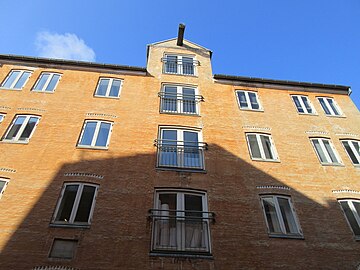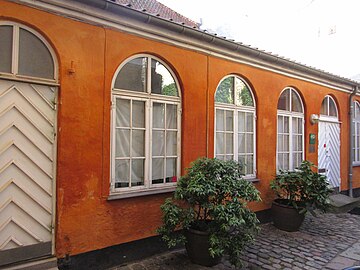
The Jennow House is a historic property located at Strandgade 12 in the Christianshavn neighbourhood of Copenhagen, Denmark. It takes its current name after Andreas Jennow, a businessman who owned it from 1949 to 1978. His company Andreas Jennow A/S was based in the building until 1988.

The Krak House is a Neoclassical property overlooking the square Nytorv in the Old Town of in Copenhagen, Denmark. It takes its name from the publishing house Kraks Forlag which was based there for many years. The Danish Centre for Culture and Development, a self-governing institution under the Danish Ministry of Foreign Affairs, is based in the building.
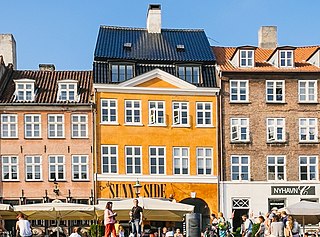
Nyhavn 31 is a listed property overlooking the Nyhavn canal in central Copenhagen, Denmark.

Nyhavn 11 is an 18th-century property overlooking the Nyhavn canal in central Copenhagen, Denmark. Ludvig Ferdinand Rømer established a sugar refinery on the property in 1653 and it was later continued by changing owners until at least the 1860s. A small figure of a sugar-baker holding a sugar cone is still seen above the gate. The building was listed in the Danish registry of protected buildings and places in 1932. Notable former residents include the general trader Jacob Severin and actors Christen Niemann Rosenkilde, Julie Sødring and Poul Reumert. The lamp manufacturer Louis Poulsen was later based in the building from 1908 to 2006.

Nyhavn 51 is an 18th-century canal house overlooking the Nyhavn canal in central Copenhagen, Denmark.Above the door is a painted stone relief depicting a lamb. The property was formerly known as Lammet and the sign was used for identification in a time when house numbers had still not been introduced. The letters are the initials of the builder Henrich Lambertsen Engel and his wife Karen Nielsdatter Holm. The building was listed in the Danish registry of protected buildings and places in 1918. It was subject to Schalburgtage during World War II but restored. Notable former residents include the portrait painter Hans Jørgen Hammer, the marine artist Carl Frederik Sørensen and Swedish actress Eva Eklund.

Nyhavn 33 is a listed property overlooking the Nyhavn canal in central Copenhagen, Denmark. A wall stone with a compass rose, a Dannebrog and two sand glasses bear testament to the fact that the building once belonged to a manufacturer of ship sails, flags and compasses.

Nyhavn 15 is a historic townhouse overlooking the Nyhavn Canal in central Copenhagen, Denmark. The building was listed in the Danish registry of protected buildings and places in 1945.
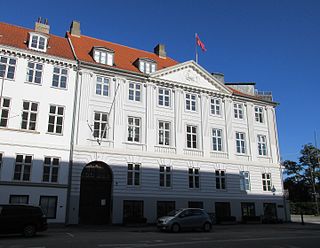
Amaliegade 40, formerly known as Toldbodbørsen, is a Neoclassical property located at the corner of Amaliegade and Esplanaden in the Frederiksstaden district of Copenhagen, Denmark. The shipping company D/S Norden was based in the building for more than one hundred years. It was listed in the Danish registry of protected buildings and places in 1918.

Nyhavn 19 is a property located at the corner of Nyhavn and Lille Strandstræde in central Copenhagen, Denmark. The building was listed on the Danish registry of protected buildings and places.

The Obel House is a Neoclassical property located at Vestergade 2 in the Latin Quarter of Copenhagen, Denmark. It was listed on the Danish registry of protected buildings and places in 1918.

Nyhavn 27 is an 18th-century property overlooking the Nyhavn Canal in central Copenhagen, Denmark. The building was listed in the Danish registry of protected buildings and places in 1945. In the 18th century, it was for a while owned by the timber merchant Andreas Bodenhoff. The building was later operated as a hotel under the name Stadt Flensburg.

Lille Strandstræde 10 is an 18th-century property situated in the Nyhavn Quarter of central Copenhagen, Denmark. It was listed in the Danish registry of protected buildings and places in 1988.
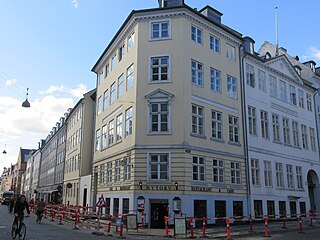
Nytorv 15/Rådhusstræde 2 is a Neoclassical property situated at the corner of Nytorv and Rådhusstræde in the Old Town of Copenhagen, Denmark. It consists of two separate buildings, the corner building from 1797 and an eight-bay building from 1798, now connected by a narrow modern infill. The building was listed in the Danish registry of protected buildings and places in 1945. Notable former residents include jurist, writer and publisher Jacob Just Gudenrath (1657–1825), actors Stephan and Eline Heger, theatrical painter Edvard Lehmann and portrait painter hristian Frederik Christensen (1805-1883).
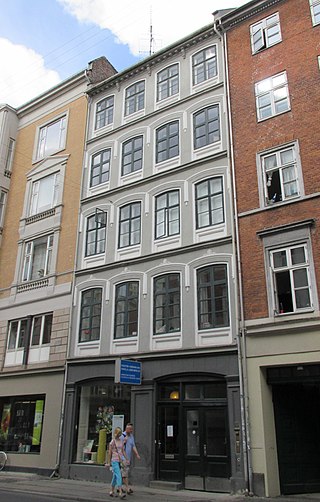
Store Kongensgade 23 is a Neoclassical mixed-use building situated in Store Kongensgade in Copenhagen, Denmark. The building fronting the street was constructed by master mason Christian Olsen Aagaard in 1850. Aagaard had already constructed the adjacent building at No. 25 in 1837, whose ground floor hosted the Royal Court Pharmacy from 1850 until 1971. The two buildings share a courtyard on their rear. At the far end of the courtyard is a former silver factory constructed in 1887 by Bernhard Hertz according to his own design. The factory was decommissioned in 1942 and was later used as office space prior to being converted into apartments in 2018. Store Kongensgade 23 and the former silver factory were listed in the Danish registry of protected buildings and places in 1989. No. 25 is not listed.

Nyhavn 45 is an 18th-century property overlooking the Nyhavn Canal in central Copenhagen, Denmark. It was listed in the Danish registry of protected buildings and places in 1945.

Lille Strandstræde 8 is an 18th-century property situated around the corner from Nyhavn in central Copenhagen, Denmark. Constructed as a two-storey, half-timbered building for Andreas Bodenhoff in the middle of the century, it was later first reconstructed in brick and heightened with two storeys in 1783 and then, in 1932, expanded with a seven-bays-long side wing on the rear. The building was listed in the Danish registry of protected buildings and places in 1959. Notable former residents include the German painter Bernhard Mohrhagen and the veterinarian Viggo Stockfleth.

Nyhavn 53, also known as Madame Tofte's House, is a residential building overlooking the Nyhavn canal in central Copenhagen, Denmark. It was constructed with three storeys in the 1750s but owes its current appearance to a renovation in the 1870s. It was listed in the Danish registry of protected buildings and places in 1932. Notable former residents include the composer Peter Arnold Heise and the ballet dancer Augusta Nielsen. The Adventurers' Club of Denmark is based in a half-timbered warehouse in the courtyard.

Nyhavn 61 is an 18th-century residential building overlooking the Nyhavn canal in central Copenhagen, Denmark. The building was listed in the Danish registry of protected buildings and places in 1945. The scope of the heritage listing was expanded in 1984. Nyhavn 61 and Nyhavn 59 have now been merged into a single property and are physically integrated on the third floor. The two buildings share a central courtyard.

Nyhavn 21/Lille Strandstræde 4, formerly known as Hotel L'ven, Hotel Kronprinsen and Fredsfondens Hus, is a complex of historic buildings overlooking the Nyhavn canal in central Copenhagen, Denmark. It consists of a late 17th-century building in Nyhavn and a just two bays wide building in Lille Strandstræde as well as a two-storey rear wing from 1748. It was listed in the Danish registry of protected buildings and places in 1945. The restaurant Cap Horn was a popular jazz venue in the 1950s. It is now part of the Tholstrup restaurant group. Notable former residents include the politician Jens Christian Christensen and painters Anna and Michael Ancher.
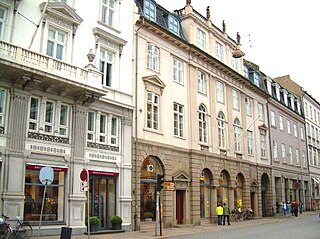
The Prior House, situated at Bredgade 33, opposite Sankt Annæ Plads, is the former headquarters of the Bruun Rasmussen auction house in Copenhagen, Denmark. The Neoclassical building was constructed in 1794 for a ship captain by master mason Andreas Hallander. It contained a single high-end apartment on each of the three upper floors.






